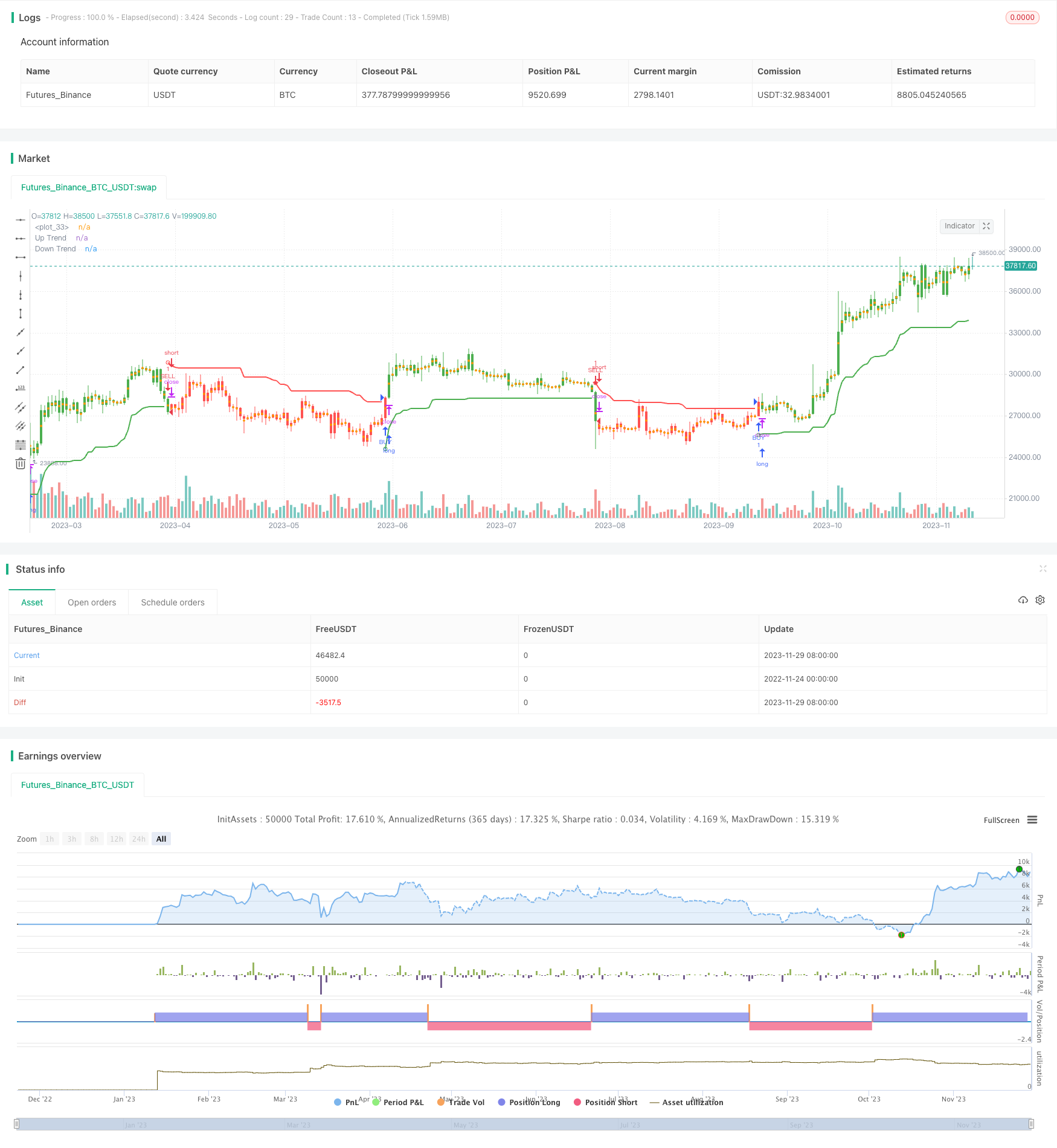Supertrend Bollinger Bands Strategy
Author: ChaoZhang, Date: 2023-12-01 16:29:56Tags:

Overview
The Supertrend Bollinger Bands strategy is a common trailing stop indicator strategy based on the ATR (Average True Range). This strategy uses the Supertrend indicator to draw bullish and bearish trend channels on the chart and generates trading signals in combination with Bollinger Bands.
Strategy Logic
The strategy uses two main parameters - period and multiplier, with default values of 10 and 3 respectively, to calculate the Supertrend lines. The specific calculation formula is as follows:
Upper Line: Close - (Multiplier x ATR) Lower Line: Close + (Multiplier x ATR)
When the closing price is higher than the previous upper line, it is considered a bullish signal. When the closing price breaks below the previous lower line, it is considered a bearish signal.
The strategy also incorporates the Bollinger Bands indicator, using the middle band as the baseline, and the upper and lower bands located two standard deviations away from it. A buy signal is generated when the price breaks above the middle band from below. A sell signal is generated when the price breaks below the middle band from above.
Advantages
- Use ATR to dynamically calculate volatility, quickly capturing market trend changes
- Combining Bollinger Bands makes trading signals more reliable
- Customizable parameters suit different market environments
Risks
- Prone to false signals in sideways markets
- Improper parameter settings may cause over-trading
- Unable to determine trend reversal points, with certain lag
Optimization Directions
- Optimize ATR period parameter to reduce noise trades using filters
- Incorporate other indicators to determine support/resistance to reduce profit retracement probability
- Add position sizing rules to limit per trade loss
Summary
The Supertrend Bollinger Bands strategy integrates the strengths of multiple technical indicators and utilizes a dynamic trailing stop mechanism to effectively track market trends. This highly customizable strategy adapts well to different markets, making it a recommended breakout chasing strategy. However, risks like whipsaws and over-trading should be addressed by further optimizations to suit more complex market environments.
/*backtest
start: 2022-11-24 00:00:00
end: 2023-11-30 00:00:00
period: 1d
basePeriod: 1h
exchanges: [{"eid":"Futures_Binance","currency":"BTC_USDT"}]
*/
// This source code is subject to the terms of the Mozilla Public License 2.0 at https://mozilla.org/MPL/2.0/
// © KivancOzbilgic
//@version=4
strategy("SuperTrend STRATEGY", overlay=true)
Periods = input(title="ATR Period", type=input.integer, defval=10)
src = input(hl2, title="Source")
Multiplier = input(title="ATR Multiplier", type=input.float, step=0.1, defval=3.0)
changeATR= input(title="Change ATR Calculation Method ?", type=input.bool, defval=true)
showsignals = input(title="Show Buy/Sell Signals ?", type=input.bool, defval=false)
highlighting = input(title="Highlighter On/Off ?", type=input.bool, defval=true)
barcoloring = input(title="Bar Coloring On/Off ?", type=input.bool, defval=true)
atr2 = sma(tr, Periods)
atr= changeATR ? atr(Periods) : atr2
up=src-(Multiplier*atr)
up1 = nz(up[1],up)
up := close[1] > up1 ? max(up,up1) : up
dn=src+(Multiplier*atr)
dn1 = nz(dn[1], dn)
dn := close[1] < dn1 ? min(dn, dn1) : dn
trend = 1
trend := nz(trend[1], trend)
trend := trend == -1 and close > dn1 ? 1 : trend == 1 and close < up1 ? -1 : trend
upPlot = plot(trend == 1 ? up : na, title="Up Trend", style=plot.style_linebr, linewidth=2, color=color.green)
buySignal = trend == 1 and trend[1] == -1
plotshape(buySignal ? up : na, title="UpTrend Begins", location=location.absolute, style=shape.circle, size=size.tiny, color=color.green, transp=0)
plotshape(buySignal and showsignals ? up : na, title="Buy", text="Buy", location=location.absolute, style=shape.labelup, size=size.tiny, color=color.green, textcolor=color.white, transp=0)
dnPlot = plot(trend == 1 ? na : dn, title="Down Trend", style=plot.style_linebr, linewidth=2, color=color.red)
sellSignal = trend == -1 and trend[1] == 1
plotshape(sellSignal ? dn : na, title="DownTrend Begins", location=location.absolute, style=shape.circle, size=size.tiny, color=color.red, transp=0)
plotshape(sellSignal and showsignals ? dn : na, title="Sell", text="Sell", location=location.absolute, style=shape.labeldown, size=size.tiny, color=color.red, textcolor=color.white, transp=0)
mPlot = plot(ohlc4, title="", style=plot.style_circles, linewidth=0)
longFillColor = highlighting ? (trend == 1 ? color.green : color.white) : color.white
shortFillColor = highlighting ? (trend == -1 ? color.red : color.white) : color.white
fill(mPlot, upPlot, title="UpTrend Highligter", color=longFillColor)
fill(mPlot, dnPlot, title="DownTrend Highligter", color=shortFillColor)
FromMonth = input(defval = 9, title = "From Month", minval = 1, maxval = 12)
FromDay = input(defval = 1, title = "From Day", minval = 1, maxval = 31)
FromYear = input(defval = 2018, title = "From Year", minval = 999)
ToMonth = input(defval = 1, title = "To Month", minval = 1, maxval = 12)
ToDay = input(defval = 1, title = "To Day", minval = 1, maxval = 31)
ToYear = input(defval = 9999, title = "To Year", minval = 999)
start = timestamp(FromYear, FromMonth, FromDay, 00, 00)
finish = timestamp(ToYear, ToMonth, ToDay, 23, 59)
window() => time >= start and time <= finish ? true : false
longCondition = buySignal
if (longCondition)
strategy.entry("BUY", strategy.long)
shortCondition = sellSignal
if (shortCondition)
strategy.entry("SELL", strategy.short)
buy1= barssince(buySignal)
sell1 = barssince(sellSignal)
color1 = buy1[1] < sell1[1] ? color.green : buy1[1] > sell1[1] ? color.red : na
barcolor(barcoloring ? color1 : na)
- Fast and Slow EMA Golden Cross Breakthrough Strategy
- RSI and Moving Average Combination MT5 Martingale Scalping Strategy
- Volatility Stop Tracking Strategy
- Oscillation Positioning Breakthrough Strategy with Multiple Indicators
- RSI Mean Reversion Quantitative Trading Strategy Based on RSI Average Crossing
- Dual Moving Average Crossover Reversal Strategy
- Moving Average Line Reverse Crossover Strategy
- Hull MA Channel and Linear Regression Swing Trading Strategy
- Triple SuperTrend Quantitative Trading Strategy
- Supertrend Trading Strategy Based on ATR and MA Combination
- Double Reversal Tracking Strategy
- Holy Grail Strategy
- Multiple Percentage Profit Exits Strategy
- Modified Price-Volume Trend Strategy Based on Price-Volume Changes
- Dual Moving Average Crossover Strategy
- Dual Indicators Combo Crazy Intraday Scalping Strategy
- Dynamic Grid Trading Strategy
- Dual Moving Average Trading Strategy
- Early Profit-Taking Moving Average Opening Bell Exit Strategy
- Monthly Parabolic Breakout Strategy